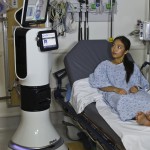Some Medical Assistants Work With Robot Doctors

As we move closer to the inevitable apocalyptic war between machines and humans that The Terminator predicted, robots continue to take on bigger and more impressive tasks — and this time, medical assistants are on the front line. You see, more and more hospitals have begun using “telepresence robots” when there aren’t enough doctors to go around.
These robots are basically “virtual doctors,” built to be human height (over five feet tall) with a monitor that displays a remote doctor’s face and cameras, microphones and speakers that allow the doctor to have real-time interaction with patients and other medical personnel. The remote physician can also access patients’ medical data and imagery, and the robots even have the ability to “drive” themselves to destinations — like a patient’s room — without user guidance, using sensors to avoid colliding with people or objects.
Doctors who can’t make it to a particular hospital to diagnose or provide advice can simply log onto a computer or tablet and teleconference with fellow doctors, medical assistants and other hospital staff using the robot. The technology is particularly useful when hospitals need the expertise of hard-to-find specialists in fields such as cardiology, neurology, pediatrics and mental health.
Currently, about 50 of the RP-VITA remote presence robots, developed by InTouch Health and iRobot, are being rented by hospitals around the world for $5,000 a month. InTouch offers several less robust “remote presence” telemedicine devices, including the RP-Lite and the hand-held RP-Xpress.
Of course, despite the ability to allow doctors to see, hear and speak remotely to patients, a robot can’t replace first-hand human interaction (at least, not until they become self-aware, autonomous killing machines), so there will always be the need for medical assistants or nurses on site to assist. Taking vital signs, making in-person observations, preparing and using medical instruments, collecting specimens, giving tests, administering medications — these are the types of duties that continue to make medical assistants invaluable, even in the face of such impressive technological advances. So, if you find yourself working with a robot doctor, make sure to let it know, “I’ll be back.”
Sources: The Washington Post, InTouch Health







